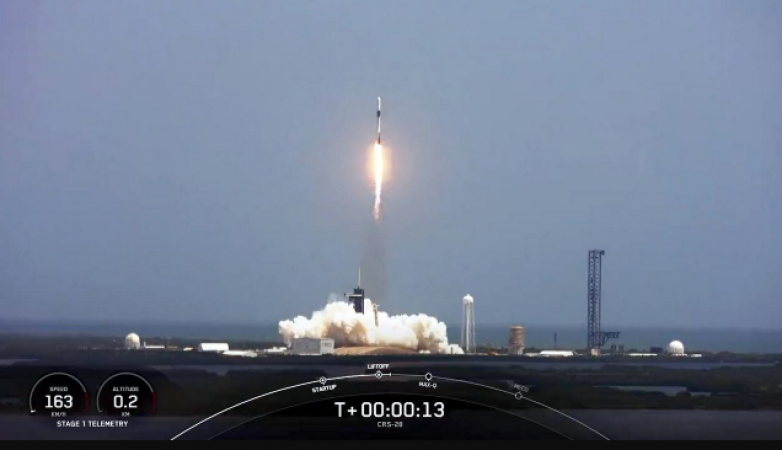
USA: The 28th Commercial Resupply Services (CRS-28) mission for NASA to the International Space Station (ISS) will be launched by SpaceX today. At 9:17 p.m., a SpaceX Falcon 9 rocket and a Dragon cargo capsule will launch from the Kennedy Space Centre in Florida.
The mission's original launch date was set for June 3, but bad weather has caused it to be delayed twice already.
Following the end of its Space Shuttle Programme, NASA contracted with two private launch companies to carry supplies and cargo to the International Space Station (ISS).
Also Read: Apple Stock Sees Record High Ahead Mixed Reality Headset Launch
The orbiting space station has been receiving cargo supplies from the two companies, SpaceX and Northrop Grumman. The CRS-28 mission makes SpaceX's total number of cargo resupply missions 28.
After stage separation, SpaceX's drone ship called "A Shortfall of Gravitas" will land the first stage of the Falcon 9 in the Atlantic Ocean. After a roughly 18-hour flight, the Dragon spacecraft will automatically dock with the ISS. The Dragon spacecraft has previously flown three missions to the ISS, namely CRS-21, CRS-23, and CRS-25. The CRS-28 mission is the spacecraft's fourth flight.
The Dragon spacecraft is expected to stay at the ISS for about a month. Then, according to NASA, it will be brought back to Earth along with research and return items, making a splash off the coast of Florida.
Also Read: How many different fields is AI completely useless?
More than 3,175 kg of payload, including scientific research, crew necessities, hardware, and food for the ISS crew, will be transported by the Dragon spacecraft.
The CRS-28 mission will bring fresh scientific research to the ISS in addition to restocking the supplies for the ongoing projects there. Studies on how plants react to stress while in space are also included in this list of technological demonstrations and research.
A pair of iROSAs (International Space Station Roll Out Solar Arrays), which will improve the space station's power supply, are also part of the CRS-28 mission supplies.
NASA astronauts will perform two spacewalks to attach the new solar arrays to the International Space Station.
Once operational, the entire collection of iROSAs will increase the power supply of the space station by 20% to 30%.
An ESA (European Space Agency) investigation to study thunderstorms will also be a part of the CRS-28 mission.
Researchers would be able to track the "inception, frequency, and altitude" of "blue discharges" from the International Space Station (ISS), which is 400 kilometres above Earth.
Atmospheric models will ultimately benefit from a better understanding of the lightning and electrical activity that occurs in the Earth's atmosphere.
Also Read: WhatsApp is working on a redesigned settings page for its iOS client
There will also be research on telomeres, which are chromosomal genetic structures that get shorter as we age. Telomeres do, however, grow longer with distance, according to research.
The ISS crew will put a method for measuring telomere length in space's microgravity to the test. According to NASA, knowing the mechanism underlying telomere lengthening could help explain potential effects on astronaut health during extended missions.
According to SpaceX, the current circumstances are "60% favourable for liftoff." However, the company has a fallback launch date of June 7 in case the CRS-28 mission does not launch today.